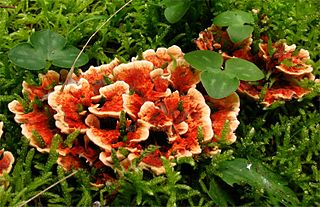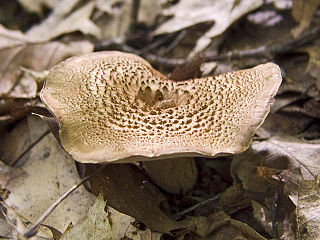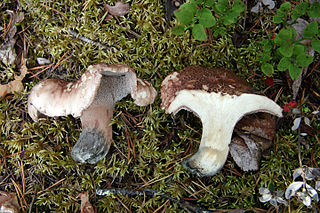
Hydnellum peckii is a fungus in the genus Hydnellum of the family Bankeraceae. It is a hydnoid species, producing spores on the surface of vertical spines or tooth-like projections that hang from the undersurface of the fruit bodies. It is found in North America, Europe, and was recently discovered in Iran (2008) and Korea (2010). Hydnellum peckii is a mycorrhizal species, and forms mutually beneficial relationships with a variety of coniferous trees, growing on the ground singly, scattered, or in fused masses.

Hydnellum is a genus of tooth fungi in the family Bankeraceae. Widely distributed in the Northern Hemisphere, the genus contains around 40 species. The fruitbodies of its members grow by slowly enveloping nearby bits of grass and vegetation. There is great variability in the form of Hydnellum fruitbodies, which are greatly influenced by environmental conditions such as rainfall and humidity, drying winds, and temperature. They are too tough and woody to eat comfortably. Several species have become the focus of increasing conservation concern following widespread declines in abundance.

Hydnellum caeruleum, commonly known as the blue-gray hydnellum, blue-green hydnellum, blue spine, blue tooth, or bluish tooth, is an inedible fungus found in North America, Europe, and temperate areas of Asia.

Phellodon is a genus of tooth fungi in the family Bankeraceae. Species have small- to medium-sized fruitbodies with white spines on the underside from which spores are released. All Phellodon have a short stalk or stipe, and so the genus falls into the group known as stipitate hydnoid fungi. The tough and leathery flesh usually has a pleasant, fragrant odor, and develops a cork-like texture when dry. Neighboring fruitbodies can fuse, sometimes producing large mats of joined caps. Phellodon species produce a white spore print, while the individual spores are roughly spherical to ellipsoid in shape, with spiny surfaces.

Hydnellum aurantiacum is an inedible fungus, commonly known as the orange spine or orange hydnellum for its reddish orange or rusty red colored fruit bodies. Like other tooth fungi, it bears a layer of spines rather than gills on the underside of the cap. Due to substantial declines in sightings, this species is listed as critically endangered in the United Kingdom.

The hydnoid fungi are a group of fungi in the Basidiomycota with basidiocarps producing spores on pendant, tooth-like or spine-like projections. They are colloquially called tooth fungi. Originally such fungi were referred to the genus Hydnum, but it is now known that not all hydnoid species are closely related.

Hydnellum ferrugineum, commonly known as the mealy tooth or the reddish-brown corky spine fungus, is a species of tooth fungus in the family Bankeraceae. A widely distributed species, it is found in north Africa, Asia, Europe, and North America. The fungus fruits on the ground singly or in clusters in conifer forest, usually in poor or sandy soil. Fruit bodies are somewhat top-shaped, measuring 3–10 cm (1–4 in) in diameter. Their velvety surfaces, initially white to pink, sometimes exude drops of red liquid. The lower surface of the fruit body features white to reddish-brown spines up to 6 mm long. Mature fruit bodies become dark reddish brown in color, and are then difficult to distinguish from other similar Hydnellum species. H. ferrugineum forms a mat of mycelia in the humus and upper soil where it grows. The presence of the fungus changes the characteristics of the soil, making it more podzolized.

Hydnellum auratile is a tooth fungus in the family Bankeraceae. Fruit bodies of the fungus consist of closely grouped, funnel-shaped caps up to 5 cm (2.0 Hydnellum aurantiacum is a close lookalike, but can be distinguished by having a white to buff cap, dull orange to brown flesh, and white spines.

Hydnellum compactum is a rare tooth fungus in the family Bankeraceae. It is characterised by its astringent taste, yellowish flesh. It is found in Europe, where it grows in deciduous forest, typically under beech. Fruit bodies of the fungus grow singly or in groups.

Hydnellum cyanopodium, commonly known as the blue foot or bleeding blue tooth, is an inedible fungus in the family Bankeraceae. It occurs in the Pacific Northwest region of North America.
Hydnellum cyanodon is a rare species of tooth fungus in the family Bankeraceae. Found in Boularderie Island and Antigonish County, it was described as new to science in 1964 by Canadian mycologist Kenneth A. Harrison. The turbinate (cushion-shaped) cap of the fruitbody measures 3–6 cm (1.2–2.4 in) in diameter. Spines on the cap underside up to 5 mm long, and blue in color. The fungus fruits singly or in groups in deep moss under spruce trees.
Hydnellum scleropodium is a rare species of tooth fungus in the family Bankeraceae. It was described as new to science in 1964 by Canadian mycologist Kenneth A. Harrison. The fungus has been collected in Tennessee, North Carolina, and Nova Scotia, in both mixed and coniferous forest. Its fruitbody has an irregular, brownish cap measuring 10–25 cm (4–10 in) wide. The sclerotium-like stipe measures 3–9 cm (1.2–3.5 in) long by 2–4 cm (0.8–1.6 in) thick, and roots into the ground. The flesh has a strong, fragrant odor. Spines on the cap underside, blue in color, are up to 11 mm long.
Hydnellum subzonatum is a tooth fungus in the family Bankeraceae. Found in Nova Scotia, Canada, it was described as new to science in 1961 by mycologist Kenneth A. Harrison. Its small fruitbodies grow as fused caps, with individual caps measuring 1.3–5 cm (1–2 in) in diameter. Initially white, they turn light brown with a somewhat darker center, and are faintly zonate. The grayish-blue spines on the cap underside are up to 3 mm long. Growing fruitbodies have an unusual hoary (grayish-white) appearance. The spores are oblong to almost square, measuring 3.5–4.5 by 3.4 µm. The fungus fruits in groups under spruce. H. subzonatum has been collected from Cape Split and Antigonish County.
Hydnellum multiceps is a rare species of tooth fungus in the family Bankeraceae. Found in Nova Scotia, Canada, it was described as new to science in 1961 by mycologist Kenneth A. Harrison. The fungus has fruitbodies of overlapping and fused caps. Single caps measure 3–5 cm (1.2–2.0 in) in diameter, while fused masses can be up to 30 cm (12 in) in diameter and 8 cm (3 in) tall. The upper cap surface is initially pale brown but darken in maturity. The greyish-brown to dark brown spines on the cap underside measure 2–5 mm long. The fungus has been recorded growing as a partial fairy ring measuring about 20 ft (6 m) in diameter, in spruce woods in Glenmont, Nova Scotia; it has also been recorded from Cape Breton Island. The spores are roughly spherical with sharp processes, and dimensions of 3–4.5 by 3–4 µm.

Hydnellum scrobiculatum, commonly known as the ridged tooth or rough hydnellum, is a tooth fungus in the family Bankeraceae. Widely distributed in the Northern Hemisphere, it is found in Asia, Europe, and North America.

Phellodon niger, commonly known as the black tooth, is a species of tooth fungus in the family Bankeraceae, and the type species of the genus Phellodon. It was originally described by Elias Magnus Fries in 1815 as a species of Hydnum. Petter Karsten included it as one of the original three species when he circumscribed Phellodon in 1881. The fungus is found in Europe and North America, although molecular studies suggest that the North American populations represent a similar but genetically distinct species.

Hydnellum underwoodii is an inedible species of tooth fungus in the family Bankeraceae. Found in North America, it was described as new to science in 1906 by American mycologist Howard James Banker. Its reddish-brown, convex to flattened cap measures 5–14 cm (2.0–5.5 in) in diameter. Reddish-brown, partially erect scales adorn the cap surface. Spines on the cap underside are 1–3 mm long; they are initially white, becoming brown with grayish tips in age. The oval to spherical spores are 6–7.5 by 5.5–6.5 µm. The fungus fruits singly or scattered, on the ground in coniferous forests.

Hydnellum joeides is a species of tooth fungus in the family Bankeraceae.

Hydnellum gracilipes is a species of tooth fungus in the family Bankeraceae. It was first described scientifically in 1886 by Petter Karsten, who called it Hydnum gracilipes. He transferred it to the genus Hydnellum in 1879. Fruit bodies of the fungus have a pinkish to reddish-brown colour, a delicate texture described as "felty or papery", and flimsy stipes. Its spores are roughly spherical with a diameter of no more than 5 µm. H. gracilipes is found in northern Europe, where it is mycorrhizal with pine. Collections made in Scotland have been found by lifting the dense ground cover of common heather, which the fungus seems to use to as support to compensate for its flimsy stipe.

Hydnellum scabrosum, also called bitter tooth or bitter hedgehog, is a species of tooth fungus in the family Bankeraceae.














